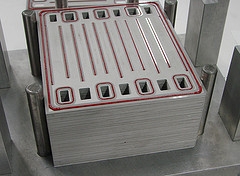April 1, 2011 — Engineers at Oregon State University have invented a new way to use surface-mount adhesives (SMAs) in the production of low-temperature, microchannel heat exchangers.
"Even though microchannel arrays have enormous potential for more efficient heat transfer and chemical reactions, high production costs have so far held back the broad, mainstream use of the technology," said Brian Paul, a professor in the OSU School of Mechanical, Industrial and Manufacturing Engineering.
 "In certain applications, this new approach has reduced material costs by 50%," Paul said. "It could cut production bonding costs by more than 90%, compared to existing approaches to microchannel lamination. And the use of surface-mount adhesives is directly translatable to the electronics assembly industry, so there is less risk going to market.
"In certain applications, this new approach has reduced material costs by 50%," Paul said. "It could cut production bonding costs by more than 90%, compared to existing approaches to microchannel lamination. And the use of surface-mount adhesives is directly translatable to the electronics assembly industry, so there is less risk going to market.
Microchannels the diameter of a human hair can be patterned into the surface of a metal or plastic, and can be designed to speed up the heat exchange between fluids, or the mixing and separation of fluids during chemical reactions. The accelerated heat and mass transfer leads to smaller heat exchangers and chemical reactors and separators.
This type of technology will be needed, researchers say, in next-generation computers, lasers, consumer electronics, automobile cooling systems, fuel processors, miniature heat pumps and more.
"We have demonstrated the use of surface-mount adhesives to create microchannels on a wide variety of metals, including aluminum, which is very cheap," said Prawin Paulraj, an OSU doctoral candidate and lead author on the recent study. "Bonding aluminum is difficult with conventional techniques."
These very thin pieces of patterned metal can be bonded one on top of another to increase the number of microchannels in a heat exchanger, and the amount of fluid that can be processed. Laminated microchannel arrays are possible in aluminum, copper, titanium, stainless steel, and other metals.
The adhesives are limited in temperature to about that of boiling water. The researchers say that possible uses might include radiators to cool an automobile engine or small, very efficient heat pumps for efficient air conditioning within buildings. Heat dissipation for electronic components could enable further miniaturization. Also read: IBM to use water cooling for future 3D IC processors
This research was conducted at the Microproducts Breakthrough Institute, a user facility of the Oregon Nanoscience and Microtechnologies Institute. A patent has been applied for and the are findings reported in the Journal of Manufacturing Processes (Access the article here: http://hdl.handle.net/1957/20495).
University officials are now seeking a commercial partner in private industry to continue development and marketing of the technology, according to Denis Sather, a licensing associate in the OSU Office for Commercialization and Corporate Development.
The Oregon State University (OSU) College of Engineering is among the US’s largest and most productive engineering programs. In the past six years, the College has more than doubled its research expenditures to $27.5 million by emphasizing highly collaborative research that solves global problems, spins out new companies, and produces opportunity for students through hands-on learning.
Follow Small Times on Twitter.com by clicking www.twitter.com/smalltimes. Or join our Facebook group

